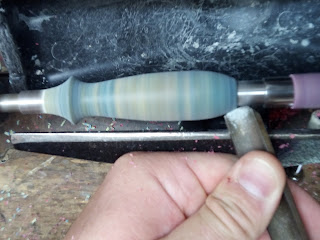So my old friend, Dave, contacted me out of the blue to commission an order and help out small businesses affected by the pandemic. Class move, man. You're awesome.
He also dropped a challenge. He wanted creativity. He wanted different. He wanted difficult. Hmmm. What about herringbone? says I. Let's see, says he. And so it began.
It had been a while since I'd made a herringbone from wood. Now I remember why. It's not that it's particularly
difficult. It just requires the patience of Job.
It starts with wood selection, marking and numbering. To make a herringbone pattern pop you need some contrasting shades, though the client specifically asked for darker woods. From top to bottom are bloodwood, Burmese teak, kolohala, and cocobolo.
The marks? Oh, that ... Each blank will be cut into 1/4" squares. The shortest blank produced 13 squares. Four blanks times 13 squares each is 52 squares. Each of the 52 squares must be sanded on 5 of its 6 sides (I leave the numbers on). That's 260 passes on the sander. Plus, each must be as close as possible in thickness to its brothers and sisters, so many (most) must be sanded to depth, compared with its peers and possibly (probably) sanded again. We have now exceeded my ability to math. My level of anal retentiveness requires that I re-align the wood grain wherever possible, hence the numbers. Hey, pimpin' ain't easy.
I tried several layouts and patterns with these woods, looking for the most aesthetically pleasing combination. This is an early draft before sanding.
So far, I've produced three herringbone blanks. The one on the left uses all four woods, the one in the middle uses three. That one in the clamps? Three new woods. Yes, that means I did that measuring, cutting and sanding again. Because masochism, that's why. Oh, and can we talk about the clamps for a minute? See, you don't want gaps, so you want to clamp your glue work in two directions. Because of the herringbone pattern, if you apply pressure one way, guess what happens in the other direction? Let's just say that it's good there are no elementary schools within earshot of the workshop, because the profanity had volume in both quantity and decibel level. Let's not even discuss the amount of glue on my hands...

The climax? Watching in what feels like slow motion as the blank succumbs to the pressures of 1200 RPMs and being drilled, exploding and casting pieces into the vacuum, onto the table and who knows where else. Don't worry. I was able to dig through the dust and garbage in the vacuum to find all the missing pieces.
I'll be fine. Really.





















































